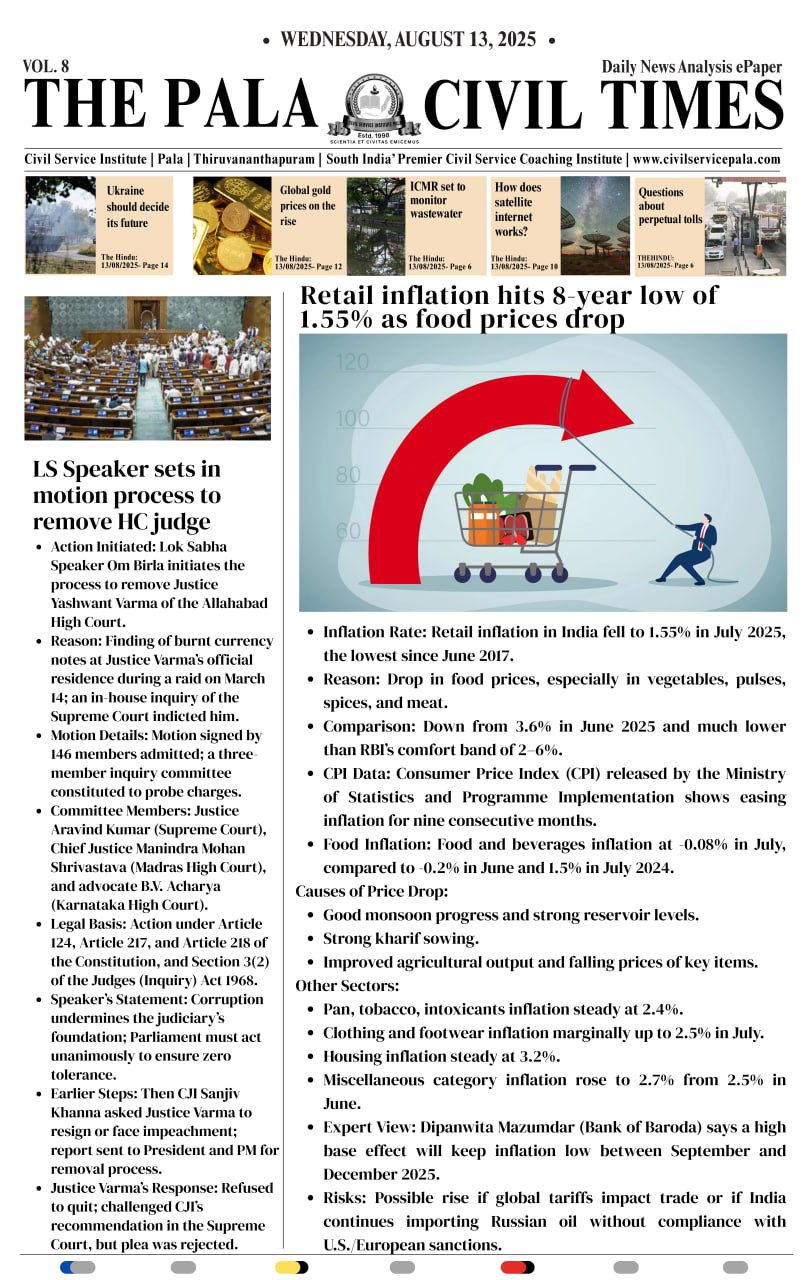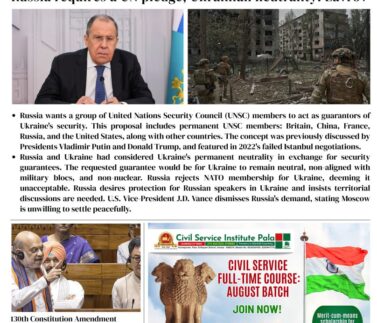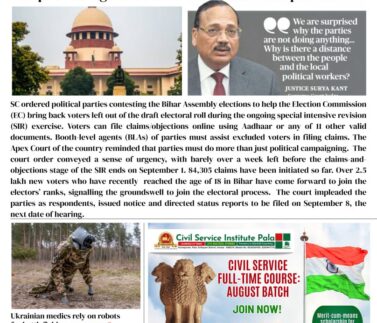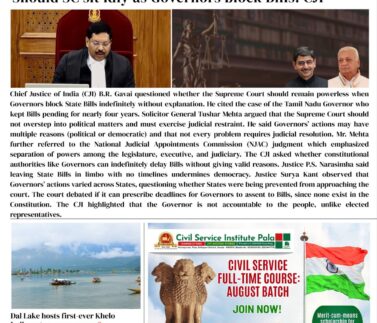
Daily News – 13-08-2025
Retail inflation hits 8-year low of 1.55% as food prices drop
- Inflation Rate: Retail inflation in India fell to 1.55% in July 2025, the lowest since June 2017.
- Reason: Drop in food prices, especially in vegetables, pulses, spices, and meat.
- Comparison: Down from 3.6% in June 2025 and much lower than RBI’s comfort band of 2–6%.
- CPI Data: Consumer Price Index (CPI) released by the Ministry of Statistics and Programme Implementation shows easing inflation for nine consecutive months.
- Food Inflation: Food and beverages inflation at -0.08% in July, compared to -0.2% in June and 1.5% in July 2024.
Causes of Price Drop:
- Good monsoon progress and strong reservoir levels.
- Strong kharif sowing.
- Improved agricultural output and falling prices of key items.
Other Sectors:
- Pan, tobacco, intoxicants inflation steady at 2.4%.
- Clothing and footwear inflation marginally up to 2.5% in July. Housing inflation steady at 3.2%.
- Miscellaneous category inflation rose to 2.7% from 2.5% in June.
- Expert View: Dipanwita Mazumdar (Bank of Baroda) says a high base effect will keep inflation low between September an December 2025.
- Risks: Possible rise if global tariffs impact trade or if India continues importing Russian oil without compliance with U.S./European sanctions.
LS Speaker sets in motion process to remove HC judge
- Action Initiated: Lok Sabha Speaker Om Birla initiates the process to remove Justice Yashwant Varma of the Allahabad High Court.
- Reason: Finding of burnt currency notes at Justice Varma’s official residence during a raid on March 14; an in-house inquiry of the Supreme Court indicted him.
- Motion Details: Motion signed by 146 members admitted; a three- member inquiry committee constituted to probe charges.
- Committee Members: Justice Aravind Kumar (Supreme Court), Chief Justice Manindra Mohan Shrivastava (Madras High Court), and advocate B.V. Acharya (Karnataka High Court).
- Legal Basis: Action under Article 124, Article 217, and Article 218 of the Constitution, and Section 3(2) of the Judges (Inquiry) Act 1968.
- Speaker’s Statement: Corruption undermines the judiciary’s foundation; Parliament must act unanimously to ensure zero tolerance.
- Earlier Steps: Then CJI Sanjiv Khanna asked Justice Varma to resign or face impeachment; report sent to President and PM for removal process.
- Justice Varma’s Response: Refused to quit; challenged CJI’s recommendation in the Supreme Court, but plea was rejected.
Port restriction on Bangladeshi jute to protect local industries: officials
- India has imposed new restrictions on the import of certain jute products from Bangladesh, with the aim of protecting its local jute industry.
- Ban on Land Ports: All land-based trade routes for the relevant Bangladeshi jute products are prohibited, sharply limiting the flow of goods and increasing logistics costs for exporters in Bangladesh.
- Location Restriction: The only permitted entry point in India for these jute products is now the Nhava Sheva Seaport, making shipping to traditional jute-consuming areas more expensive and less competitive due to circuitous routing.
- Protecting Local Industry: Several jute mills in India have shut down recently, and domestic jute prices fell below the government-set Minimum Support Price (MSP).
- Trade Tensions: The move is also viewed as a reciprocal or retaliatory measure in response to Bangladesh’s trade restrictions on Indian goods, especially restrictions affecting the northeastern states. Recent months have seen escalating trade tensions, with both sides limiting access to certain goods via land borders.
- Impact on Bangladeshi Exporters: The new sea-only route raises costs for Bangladeshi jute products, likely making them less competitive in India and, at least in the short term, providing relief to Indian producers.
- Despite earlier anti-dumping duties, Bangladeshi jute imports to India had remained persistently high, contributing to the distress of Indian mills.
18th International Olympiad on Astronomy and Astrophysics inaugurated in Mumbai
- Event: 18th International Olympiad on Astronomy and Astrophysics (IOAA) inaugurated in Mumbai.
- Participants: Over 300 high school students from 64 countries.
- Host: Homi Bhabha Centre for Science Education at the Tata Institute of Fundamental Research
- Theme: Vasudhaiva Kutumbakam – “the ancient Indian idea of world as one family.”
- Focus Areas: Use of advanced instruments, computation, AI, machine learning in astronomy, with scope for future innovations.
- Competition: 10-day event with several challenging exams; students from Class 10–12 selected after a rigorous process.
- History: IOAA started in 2007 in Thailand; this is the second time India is hosting, the first being in 2016 in Bhubaneswar.
Cabinet gives approval for four semiconductor plants
- India’s Union Cabinet has approved the establishment of four new semiconductor plants as part of the India Semiconductor Mission, marking a major expansion of domestic chip manufacturing aimed at reducing import dependency and positioning India as a significant player in the global electronics supply chain.
- Project Locations: Odisha (2 plants in Bhubaneswar), Punjab (Mohali), Andhra Pradesh
- Jobs Created: Over 2,000 direct skilled jobs plus indirect employment across the electronics manufacturing ecosystem
- Sector Impact: The plants will boost local capabilities in fabricating, packaging, and testing advanced chips and components, critical for sectors like automobiles, telecom, defense, and consumer electronics.
- Ecosystem Growth: The total India Semiconductor Mission portfolio now includes 10 projects across six states, with cumulative investments approaching ₹1.6 trillion.
- Value Addition: With the approvals, India aims to exceed 30% value addition in electronics locally— compared to nearly 20% today.
- This Cabinet approval is part of India’s urgent drive to build Atmanirbhar Bharat (self-reliant India) in chip technology, harnessing global partnerships (including Intel and Lockheed Martin-backed units) while creating a robust talent pool and research ecosystem throughout the country
PRELIMS CORNER :
- Which of the following statement is correct about Philips Curve?
- According to this curve, the unemployment will be high at high rate of inflation.
- The unemployment will be less at high rate of inflation.
- Tax collection will be low at high rate of tax.
- The more the price, the more will be the demand.
- It is a central sector scheme which aims to produce Agro-marine processing Development of Mega Food Parks is one of the seven components of the scheme. Identify the scheme from the options given below.
- PM Krishi Sinchayee Yojana
- PM Sampada Yojana
- PM Samman Nidhi
- PM Mudra Yojana
- Which among the following is the largest component of Foreign Exchange Reserve of India?
- Gold
- Special Drawing Rights
- Reserve position with the IMF
- Foreign Currency Assets
4.I.R Coelho case has been an important one in the constitutional history of independent India. What is it related to?
- Seventh schedule
- Limitations of parliament
- Ninth Schedule
- Right to education
IAF prioritises induction of long-range missiles after Operation Sindoor success
- Operational Context: Following the success of long-range standoff weapons in Operation Sindoor, the Indian Air Force (IAF) is prioritising induction of air-to-ground and air- to-air missiles with strike ranges over 200 km.
- Purpose: This move aims to allow the IAF to engage targets from safer distances, avoiding enemy air defence systems.
- Weapons Used in Operation Sindoor: BrahMos, SCALP, Rampage, and Crystal Maze missiles — capable of hitting targets 250–450 km away, bypassing Chinese HQ-9 systems.
- Development Plans:
- DRDO to accelerate development of longer- range variants of the indigenous Astra air-to- air missile.
- Interest in acquiring the Russian R-37 missile (range over 200 km).
- Air Defence Initiatives:
- Rapid progress sought on Project Kusha, an indigenous long-range air defence missile system.
- Plans to procure at least two squadrons of the Russian S-400 Triumf system.
- Recent Achievements: IAF recently set a record by downing a surveillance aircraft at over 300 km range using the S-400 system.
- Strategic Impact: Deployment of S-400 has forced Pakistan Air Force to change its flight patterns to evade detection and targeting.
ICMR set to monitor wastewater for 10 viruses in 50 cities
- Initiative: Indian Council of Medical Research (ICMR) to begin wastewater surveillance for 10 viruses in 50 cities, up from the current 5 cities.
- Purpose: To detect any increase in viral growth early, enabling timely public health interventions.
- Timeline: Surveillance scaling to take place over the next six months across India.
- Current Monitoring: COVID-19 and polio viruses already under wastewater surveillance.
- Method: Environmental surveillance through monitoring of surface water and wastewater, especially in outbreak- prone areas, for early warning.
- Target Viruses: Includes influenza virus (AIV) and influenza-like illnesses (ILI), along with severe acute respiratory illness (SARI) pathogens.
- Additional Efforts: Antimicrobial resistance (AMR) surveillance already ongoing in several hospitals.
- AMR Concern: AMR is the ability of microorganisms (bacteria, viruses, fungi, parasites) to resist medication effects, leading to prolonged illness, higher costs, and increased mortality.
How does satellite internet work?
Need for Satellite Internet:
- Provides connectivity in remote or disaster-hit areas where ground infrastructure is unavailable or damaged.
- Useful during earthquakes, floods, and other crises when normal communication fails.
Features of Satellite Internet:
- Dual structure: ground segment (antennas, receivers, network operation centers) and space segment (satellites).
- Works without physical cables, useful in areas lacking infrastructure.
Satellite Orbits:
- GEO (Geostationary Earth Orbit): ~35,786 km above Earth, fixed position, good for stable coverage but high latency.
- MEO (Medium Earth Orbit): ~2,000–35,786 km, used for navigation systems.
- LEO (Low Earth Orbit): 200–2,000 km, low latency, requires many satellites in a constellation.
Advantages:
- Coverage in inaccessible areas.
- Can bypass damaged infrastructure.
- Increasing affordability of small satellites makes deployment easier.
Challenges:
- High cost of launch and deployment.
- Latency issues (especially with GEO).
- Needs large constellations for continuous coverage in LEO, increasing costs.
Applications:
- Remote education, telemedicine, emergency response.
- Internet connectivity for rural and remote communities.
Global Trends:
- Nations are increasingly viewing satellites as a key part of internet expansion strategies.
- Crucial for countries like India to integrate satellite internet into digital inclusion policies for faster economic growth.
Govt. refrains from specifying valid IDs for citizenship
- No Specific List of Valid IDs: The Union Home Ministry has not specified categories of valid documents required to prove citizenship in India.
- Governing Law: Citizenship is regulated by the Citizenship Act, 1955 and its rules.
- Bihar Voter Roll Revision: Special intensive revision (SIR) of electoral rolls in Bihar includes birth certificates among 11 acceptable documents for voter list inclusion.
- Parliamentary Question: Response given to CPI (ML) MP Sudama Prasad, who sought details on required documents and total number of birth certificates issued in the last 25 years, as well as coverage of birth and death registration.
- Citizenship Acquisition Methods: By birth (Section 3)
- By descent (Section 4)
- By registration (Section 5)
- By naturalisation (Section 6)
- By incorporation of territory (Section 7)
- Eligibility Criteria: Determined under provisions of the Citizenship Act, 1955.
- August 5 Statement: Ministry clarified that the Citizenship Act does not require compulsory registration or issuance of national ID cards to every Indian citizen.
Panel questions ‘perpetual’ highway tolls, demands removal after cost recovery
- PAC Recommendation: Public Accounts Committee (PAC) suggests reducing or scrapping highway tolls once capital and maintenance costs are recovered.
- Tariff Authority Proposal: Panel proposes a tariff authority for fair toll determination.
- Automatic Refund/Waiver: Recommends a technology-driven and transparent system for automatic toll refunds or waivers when highways are under maintenance or unfit.
- Rationalisation of Tolls: Toll collection should be substantially reduced after cost recovery, and continuation beyond this point should require clear justification and independent oversight.
- Perpetual Toll Issue: The concept started with a 2008 amendment allowing toll collection beyond project cost recovery; further reinforced in 2023 fee rules amendment.
- Post-Concession Handling: After concession ends, assets go to the National Highways Authority of India (NHAI) and toll revenues go to the Consolidated Fund of India.
- FASTag Concerns: Despite FASTag adoption, congestion persists due to scanner failures; recommends on-site facilities for recharge/replacement and real-time monitoring with data-driven decisions.
Global gold prices likely to double if dollar is devalued’
Gold Price Projection:
- International spot gold prices could reach $7,000/ounce by 2030 if the U.S. dollar is devalued.
- Current price is about $3,400/ounce.
Reason for Possible Devaluation:
- U.S. aims to shift from being the world’s consumer to a net producer.
- This requires a cheaper currency, increased capital inflows, and bullishness on real assets like gold.
How Devaluation Could Happen:
- Policies such as capital controls, tariffs, and zero-trade deficit goals.
- Even without an official devaluation, tariffs and trade controls could weaken the dollar.
Expert Views:
- Anindya Banerjee (Kotak Securities): A cheaper dollar benefits gold prices.
- Maneesh Sharma (Anand Rathi): Planned devaluation unlikely due to risk of losing reserve currency status, but a cheaper dollar from trade restrictions would still raise gold prices.
Safe-Haven Demand:
- Gold could serve as a hedge against inflation and market uncertainty.
- Expected demand surge in late 2025 or early 2026 could push prices to
$3,800–$4,000 in the near term.
Market Context:
- Rising gold prices tied to global economic uncertainty, trade policies, and inflation trajectory.
Ukraine should decide its future, says EU ahead of Trump-Putin meet
EU Position:
- European countries (except Hungary) affirm that Ukraine must determine its own future regarding the Russia-Ukraine war.
- Any meaningful negotiations should include Ukraine and can only occur in the context of a ceasefire or reduced hostilities.
Trump-Putin Talks:
- U.S. President Donald Trump and Russian President Vladimir Putin to meet in Alaska to discuss a ceasefire.
- Concerns among European leaders that Trump and Putin could make a deal without Ukraine’s involvement.
Ukraine’s Stance:
- President Volodymyr Zelensky rejects any idea involving “swapping” of territory as part of a ceasefire.
- Russia already controls approximately a fifth of Ukraine’s territory.
Hungary’s Position:
- Hungary did not sign the EU statement, with PM Viktor Orban maintaining relatively strong ties with Moscow.
- Orban stated that the EU leaders’ statement was setting conditions for a meeting to which Hungary was not invited.
Diplomatic Efforts:
- German Chancellor Friedrich Merz has scheduled a virtual summit with Trump, Zelensky, and EU leaders.
- Trump has promised to update European leaders after his talks with Putin.
Prelims Corner: Explanations
Q1. Ans b
The Phillips curve is a graphic representation of the inverse relationship between unemployment and inflation. According to the hypothesis, the lower the unemployment rate, the higher the rate of inflation, and vice versa. As a result, high levels of employment can be obtained when inflation is high.
Q2. Ans b
Government of India had approved the umbrella Central sector scheme, SAMPADA- Scheme for Agro-marine processing and Development of Agro- processing Clusters with a total allocation of Rs.6000 crore on 03.05.2017 for implementation period 2016-2020 coterminous with the 14th Finance Commission cycle. The scheme has been subsequently renamed as ‘Pradhan Mantri Kisan SAMPADA Yojana (PMKSY)’. PM Kisan SAMPADA Yojana was envisaged as a comprehensive package which will result in creation of modern infrastructure with efficient supply chain management from farm gate to retail outlet. It will not only provide a big boost to the growth of food processing sector in the country but also help in providing better returns to farmers
Q3. Ans d
Foreign exchange reserves are assets held on reserve by a central bank in foreign currencies, which can include bonds, treasury bills and other government securities. The biggest contributor to forex reserve is foreign currency assets followed by the gold, SDR, and reserve with the International Monetary Fund. The most significant objective behind this is to ensure that RBI has backup funds if their national currency rapidly devalues or becomes altogether insolvent.
Q4. Ans c
Coelho case is one of the landmark judgments on the interpretation of the doctrine of basic structure of the constitution as laid down in Kesavananda Bharti case. In this case, a nine-member bench of Supreme Court held that ninth schedule items are not immune to judicial review as it is part of the constitution. Further, nothing in the Ninth schedule can abrogate fundamental rights as they form basic features of the constitution. The objective behind Article 31B of the Constitution is to remove difficulties and not to wipe out judicial review per se.
Case Study:
The court questioned whether the “potentiality of abuse” of Section 152 of the Bharatiya Nyaya Sanhita (BNS) could justify declaring it unconstitutional. Section 152 punishes “acts endangering sovereignty, unity and integrity of India”. Petition filed by the Foundation of Independent Journalism and Siddharth Varadarajan (The Wire) over an FIR in Assam under Section 152 and other provisions for a news article. SC protected Varadarajan and Foundation members from coercive police action. Advocate Nitya Ramakrishnan argued it is vaguely worded, creating scope for misuse and chilling free speech, especially for journalists. Compared it to colonial sedition law (Section 124A of IPC), noting that while wording differs, the effect is similar. Question raised on whether a challenge to a provision could justify anticipatory bail or quashing of FIRs. Discussion on whether custodial interrogation is necessary in cases involving journalists; government argued it cannot give a blanket protection.



